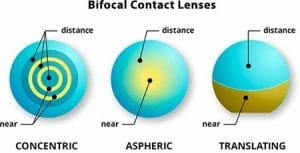Bifocal and multifocal contact lenses are perfect solutions to refractive errors and presbyopia. They provide clear vision at for near as well as distant objects.

People above the age of 40 have a high chance of developing presbyopia. The main sign of having presbyopia is that you need to hold a book, magazine, phone and other reading material at some distance from the eye to see them clearly.
Bifocal and multifocal contact lenses are available in both rigid gas permeable (GP) and soft materials. Also, you can get them as hybrid contact lenses. They are available in daily, monthly and yearly disposable lenses.
Some multifocal contact lenses are made of silicone hydrogel material which allows more oxygen to penetrate through it to the cornea. These lenses are more comfortable to wear than conventional soft lenses.
Difference between bifocals and multifocal contacts?
Bifocals lenses have two different prescriptions on them. Multifocal contact lenses have multiple ranges of power in each lens.
How bifocal and Multifocal lens works
Bifocal and multifocal lens are available in different designs and each design works in a different way depending on the design of the lens. There are two basic groups of designs:
- Segmented designs
- Simultaneous vision designs
Segmented designs
Segmented designs are also called translating or alternating designs. These rigid gas permeable multifocal lenses have the centre and the top portions of appropriate power for seeing distant objects. And, the lower portion has added magnifying power for near vision.
Simultaneous Vision Designs
These multifocal lenses have specific regions for near and far viewing. They also have an intermediate viewing portion as well. The wearer uses the portions of the lens for the sharpest vision depending on the object being viewed. Simultaneous vision design has two different designs: Aspheric and concentric.
Aspheric Multifocal contact lenses
In the aspheric multifocal contacts, the power gradually changes from far to near without any visible line in the lens.
Aspheric multifocal lenses are simultaneous vision lenses which means your visual system will have to select the proper lens power for the moment.
These lenses are available as daily, weekly and yearly disposable lens for correction of presbyopia.
Concentric Multifocal Contacts
Concentric multifocal contact lenses have the lens power for viewing far objects in the centre of the lens which is surrounded by the rings of the near and far lens power of like bifocal contact lenses.
Normally, there are two concentric power rings in the pupil area in normal light. However, this varies as the pupil constricts or dilates due to changing light conditions.
Concentric bifocal lenses are available in both rigid gas permeable and soft materials.
Should I use bifocal contact lenses?

Bifocal contacts have been around for many years but they got famous only recently. One of the reasons, they didn’t get famous before is that the older designs were not satisfactory which lead to frustration among the wearers as well as the prescribers.
Today, many successful designs have been produced using new technology which provides you with a number of options.
Doctors use techniques like monovision and modified monovision with bifocal contact lenses. In monovision, one eye has near prescription lens and the other contains a distant prescription. Modified monovision involves using single vision lens on one eye and a multifocal lens on the other eye.
An effective alternative to multifocal contact lenses and monovision is to wear progressive lens eyeglasses over the contact lenses. Wearing progressive lenses glasses over contact lens is usually preferred over reading glasses because full-sized glasses with progressive lenses look more good than the regular glasses.
Progressive lenses can correct a small refractive error like astigmatism which are not completely corrected by the contacts. Therefore, progressive lenses eyeglasses offer you sharper vision. Also, they provide clear vision at all distances liberating you from putting on and taking off glasses.
Which bifocal contact lens should I get?
 Your eye care practitioner will consider two factors when choosing a bifocal contact lens; the size of the pupil and your near prescription.
Your eye care practitioner will consider two factors when choosing a bifocal contact lens; the size of the pupil and your near prescription.
Generally, aspheric multifocal contact lenses are best suitable for mild to moderate presbyopia. And, segmented or concentric multifocal contacts are better for advanced presbyopia.
You may have to try out different bifocal contact lens designs before you find the right one. Many eye care practitioners offer free trial lenses to help you find a suitable one.


